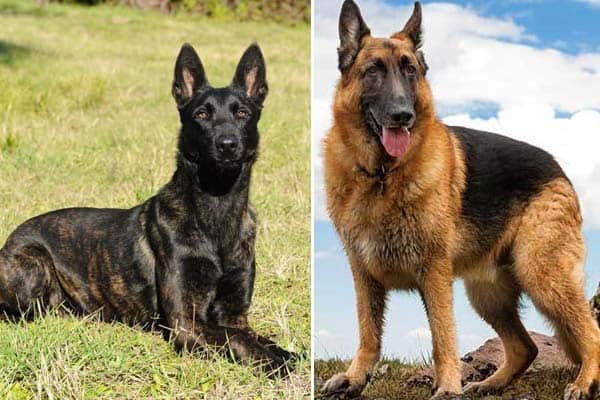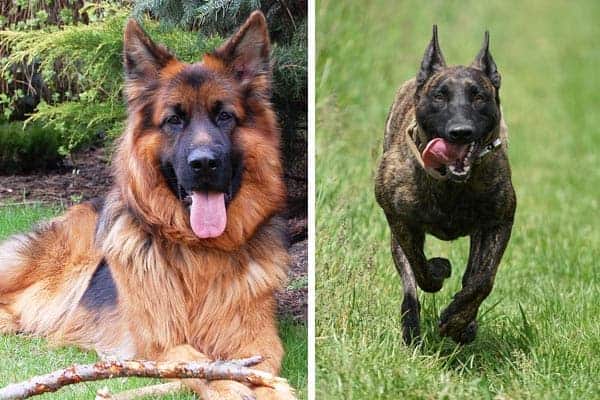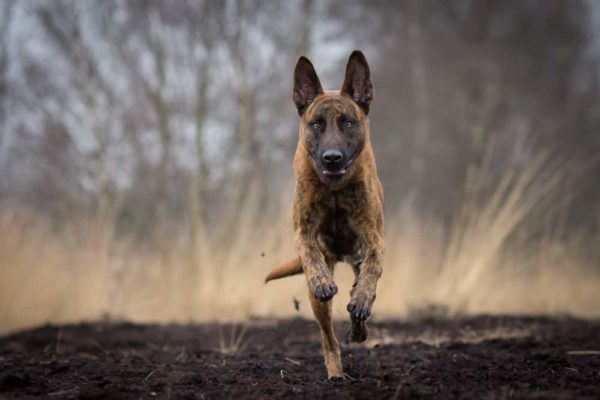German Shepherd vs Dutch Shepherd: An In-Depth Look At These Cousins
Several hundred dog breeds exist in our world today. It is hard to believe that they all originated from a wolf in the wild.
In the case of the Dutch and German Shepherd, these breeds are very close in composition to their wild ancestors. But how can you tell these Shepherd breeds apart?
There are characteristics that both separate and unite these two breeds. From origin to temperament to health issues, you can work to understand the varying facts that make these breeds unique.
And if you mistakenly thought there was no difference, you will be pleasantly surprised to know otherwise.

Dutch Shepherd vs German Shepherd: What Was Their Original Purpose?
Aside from the obvious difference in geographical location, let’s discuss the origin of these beautiful breeds and how they came to be.
Origin of the German Shepherd
In the days which spawned the German Shepherd, German breeders were working diligently to create a dog breed that was ideal for working.
Phylax Society was formed with the responsibility of standardized dog breeding, attempting to produce the ideal specimen.
Von Stephanitz, a former member of the society, searched for the perfect work dog. He purchased Horand at a local dog show.
Horand possessed all the beauty, intelligence, skill, and work ethic that he felt the perfect dog should possess.
Horand became the first registered German Shepherd in history in 1899. That marked the beginning of one of the most widespread dog breeds today.
In fact, according to the American Kennel Club, German Shepherds were last documented as the second most popular breed of dogs as of 2018.
Origin of the Dutch Shepherd
The Dutch Shepherd, originating in the Netherlands, is often confused with the German Shepherd due to physical similarities.
This rarer breed was actually registered a year earlier than the German Shepherd, first documented in 1898.
Much like their cousin, they were bred for work purposes. Living conditions were harsh in this century.
They required a dog who was hearty, capable, and intelligent. This breed was responsible for herding and guarding to protect families and farm life, specifically flocks of sheep.
Many families relied on them to help them thrive. They are naturally labor-oriented, taking a load off their owners. As time progressed and modern advancements flourished, their purpose at the time diminished.
Although this breed reached near extinction between 1940-1950 due to lack of necessity, they still exist today.
However, they are incredibly rare and difficult to find. You will find that you have to do your research and may have to travel to purchase this breed.

What Are Their Individual Physical Attributes and How Exactly Do They Differ?
The two Shepherd breeds are easily confused for one another, as they are similar in body structure and color. It is no surprise, as they are directly related and bred for parallel reasons.
German Shepherd Structure and Appearance
This is a large dog breed, reaching a height of 22-26 inches. They can range in weight roughly between 49-88 pounds.
German Shepherds come with a double coat. That means they have a short, dense undercoat with a layer of longer hairs over the top.
The classic coloring is black and tan, but they can come in variations of all white, all black, sable, red and black, cream and black, and blue. They also have a very recognizable black mask.
They are closely related to wolves, resembling the body structure. They are sleek and muscular, with their backs arching in a downward curve.
Due to their size and stature, they can appear very intimidating. They have a long snout with one of the most powerful bite forces of any breed.
The life expectancy of the German Shepherd on average is 9-13 years, which is not an unusual expectancy for a larger breed.
Dutch Shepherd Structure and Appearance
This is a medium-large breed of dog, reaching a height of up to 21.5-24.5 inches. Their weight ranges a bit more, swaying between 50 and 75 pounds.
Dutch Shepherds come in three coat types: long, short, and rough. Their coats are typically course to the touch. The long coat is straight; however, the shorter and rough coats can be wavy.
While coat type may vary, they have very distinct brindle markings, which sets them apart from other Shepherds.
The color can range from very light silver to chestnut red. Most of them have a full black mask. They do shed, and it can be quite a lot. Regular grooming is advised.
They are built to be athletic and have lean, muscular bodies. Since they were bred for herding purposes, they have a physique that allows them to be agile and nimble.
Their structure provides quick response times and precision.
The life expectancy of a Dutch Shepherd is 13-15 years, which is likely longer due to their slightly smaller stature.
How Do These Two Breeds Scale Relating to Trainability and Intelligence?
Both breeds were bred with the intent of easy trainability. Since they were primarily used to herd and guard, they needed to be responsive and cooperative.
Both breeds learn quickly and perform with great efficiency.
German Shepherd Capabilities
They have been ranked the third smartest breed of dog, just beneath the poodle and border collie. Because of their infamous trainability, they are widely used today to perform a variety of specialized duties.
According to GermanShepherdGuide, This breed has been trained to be aces in the following areas:
- Military Dogs
- Search and Rescue
- Detection of narcotics, explosives, and human remains
- Personal Protection Dogs
- Service Dogs
- Therapy Dogs
Because of their wonderfully athletic nature, they can still fulfill their original purpose, which is herding and farming.
As for companion tasks, they will keep your lifestyle an active one. They enjoy walking, hiking, swimming, and fetching games.

Dutch Shepherd Capabilities
Like the German Shepherd, these dogs are highly trainable and incredibly bright. Shepherds of all variations were bred to be in the working arena, so they were genetically geared to be quick learners.
The Dutch Shepherd is no exception to this rule. They follow suit with superiority.
Of all the Shepherd breeds, Dutch Shepherds score the highest in terms of agility, obedience, and service. While not as common, it makes them just as efficient to perform service tasks, according to PetGuide.
When training, the trainer must assert their dominance. Because of the intelligence this dog possesses, they may even believe they can outsmart the trainer.
When you assert yourself as the alpha, you win the animals respect and enhance their overall work presentation.
Dutch Shepherds also have service roles such as:
- Guide Dogs
- Rescue Dogs
- Police Dogs
- Training Dogs
- Companions
They have just as much energy as the Germans, needing a way to channel their energies. Their vigor and willingness to learn to help them easily pick up on new tasks and tactics.
They take their duties very seriously and maintain excellence in the role they are elected.
Are There Health Concerns or Common Ailments for Either of These Breeds?
Any purebred canine comes with certain risk factors for health issues.
Because of breeding, genetics, body structure, and environmental factors, even the healthiest breeds come with their own set of potential conditions.
German Shepherd Health Issues
German Shepherds are typically a very hearty and healthy breed. With proper diet and exercise, many potential problems can be averted entirely.
However, they do have certain areas where problems can arise.
Perhaps the most common issue with the German Shepherd is hip and elbow dysplasia.
This condition is where the ball and joint of the hip bones do not fit together correctly, causing the eventual loss of functionality in the joint altogether.
While it is a genetic predisposition, other factors can make the chances of developing dysplasia more likely.
Improper nutrition or weight, as well as the growth rate of the dog, play huge factors in the development. Though it cannot always be avoided, preventative measures exist.
Another common health issue seen among this breed is degenerative myelopathy, which affects the neurological system of the dog.
There is a salvia test that can be done to see if a dog is a carrier of the disease.
It is also not uncommon to see issues with the pancreas and musculoskeletal system.

Dutch Shepherd Health Issues
Health problems for this breed are generally very low. Like their German cousins, they also have reported issues with hip and elbow dysplasia as well as musculoskeletal issues.
The rates are lower, but exist, nonetheless.
According to Wikipedia, Many reports indicate this breed has genetic disorders involving allergies, inflammatory bowel disease, and pannus.
In the long-haired Dutch Shepherds, there is a known problem called goniodysplasia. This disease occurs from drainage issues in the eye. If untreated, it can end up leading to eventual blindness.
Proper exercise and nutrition is a crucial elements to help the breed thrive.
Because of their allergy-prone nature, they could develop food sensitivities. Working together with a veterinarian to get a proper diet implemented may be necessary.
Where Do Both Breeds Stand in Terms of Personality and Sociability?
Personality plays a huge role in determining what an animal is best suited for in its life. Just as humans have a multitude of interests, character flaws, and specific traits, so do animals.
While each dog will vary from individual to individual, there are some overall expectancies you can typically pinpoint with different breeds.
German Shepherd General Disposition
Due to what you have already read about this breed, it should come as no surprise that they are exceptionally obedient.
While they can have a stubborn streak, they are notoriously loyal to their owners. They are faithful to a fault and loving to their family.
They are well-known for having an alpha mentality. That attitude can make them questionable with unknown animals, but they generally do well with animals they are familiar with.
That also means that owners must train them to listen to their commands at an early age so that they don’t confuse their authority with yours.
Because of their high-alert senses and their overall protectiveness, they are aloof and wary of strangers.
They have a strong urge to protect their owners and can be standoffish or even aggressive if they feel someone is a threat.
German Shepherds have been labeled as dangerous in the past. While they can pack a punch, having quite powerful jaws, they aren’t inherently aggressive unless they feel an outside force poses a danger.
According to KnrLegal, They have gotten a bit of bad press, ranking high up on the list of biting humans, it is more likely due to a lack of training or instinctual reactions to perceived hazards.
They are wonderful companion animals. They happily accompany owners on jogs, walks, trips, and other outings.
Because they are typically calm and patient, they tend to be very good with children. They will also make excellent guard dogs, alerting when something isn’t right or when they see a stranger nearby.
When purchasing this breed, you will pay anywhere from $300-$1,000 for a companion animal. However, if you opt for a pre-trained service animal, you can pay $6,000 or more.
Dutch Shepherd General Disposition
The intelligence of the Dutch Shepherd makes them extremely intuitive towards human emotions. They are highly alert and aware.
As previously mentioned, they are incredibly trainable, and you will likely have to spend some time doing so.
Whether the dog’s role will be to be a companion animal or service animal, asserting a human as the alpha is necessary to implement.
They will need to know their place, so they don’t think that they rule you instead.
Dutch Shepherds are loving, loyal, and adventurous pets. Like their German cousins, because they are so active and animated, they will need owners who reflect their lust for life.
Having not enough to do can lead to destructive behaviors.
Since this breed is not as common as other Shepherds, you don’t hear of them biting humans as often.
However, because of their high level of instinct to protect those they consider their pack, they can be suspicious of strangers.
Though they may take a while to warm up, they may let their guard down when they see you aren’t going to do anything abnormal.
When properly raised with adequate exercise, affection, socialization, and training, these dogs are fabulous candidates for any role they are given.
If you are purchasing a Dutch Shepherd as a pet, due to their rarity, they range in price from $1,000-$3,500.
A Quick Review: Key Points in Similarities and Variances Between Breeds
While these canine cousins are very similar, we learned some interesting differences as well. Let’s go back over them to get a good look at the facts.
Similarities
- Each breed was intended for herding and farm work
- They were both registered around the same time
- Both make excellent work and service dogs
- Both make wonderful companion pets
- They have remarkable intelligence and trainability
- They require frequent stimulation and physical activity
- They are very protective and territorial
Differences
- German Shepherds are larger in size
- Dutch Shepherds are rarer to find, where German Shepherds are one of the most common dogs today
- German Shepherds are at a greater risk for health issues
- Dutch Shepherds are more expensive
- Dutch Shepherds have coats only in brindle patterns
As you can see, there are so many ways they mirror one another but are just different enough to be one of a kind.
Watch an interesting video overview of the German Shepherd and of the Dutch Shepherd. These videos add to the facts of each breed and expand on what you have already read.
Dutch Shepherd vs German Shepherd: Both Great Choices
Shepherd breeds have come so far in the world today. While coming into existence in the 1800s, they have flourished.
Even when the Dutch Shepherd faced potential extinction, it conquered the odds and is still brilliantly thriving today.
Not only do these amazing breeds make valuable additions to their human families, but they also assist humanity with some of the hardest tasks.
It is safe to say these two breeds will continue to be both purposeful and adored for the foreseeable future.






























